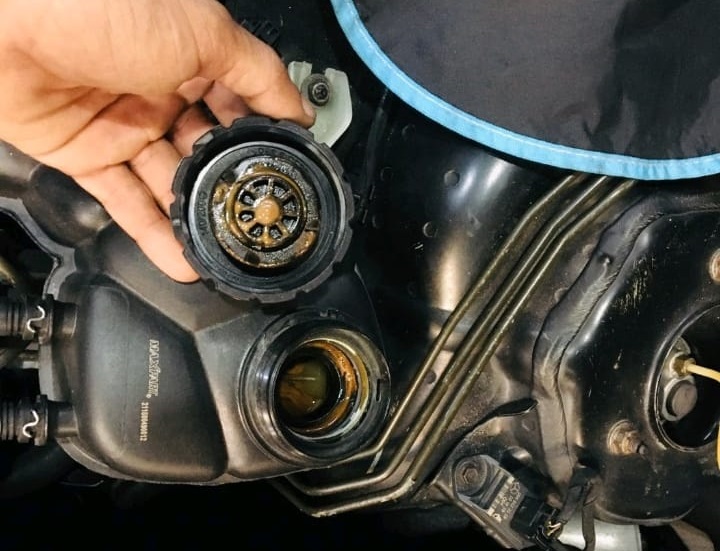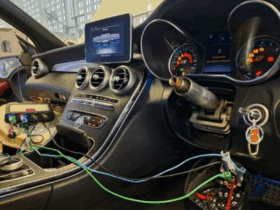Table of Contents
Case Study: Coolant Mixed with Oil in a Mercedes-Benz S Class W221 (M272 Engine)
In the world of automotive maintenance, few problems are as alarming and potentially damaging as coolant mixing with engine oil. This issue can compromise lubrication, accelerate wear, and if ignored cause catastrophic engine failure.
In this case study, we’ll look at a real-world repair involving a Mercedes-Benz S Class W221 S350 with the M272 Engine, where coolant had mixed with oil. We’ll explore the symptoms, diagnostic process, repair solution, and final outcome, offering valuable lessons for owners and technicians alike.

Vehicle Case Details
- Model: Mercedes-Benz S Class W221 S350
- Engine: M272
- Customer Complaint: Coolant mixing with engine oil
This complaint immediately raised concerns of a major sealing or cooling system issue that needed urgent attention.

The Issue: Coolant Mixed With Oil
The customer noticed coolant loss and later discovered oil contamination in the expansion tank. On inspection, the workshop confirmed that coolant and oil were mixing inside the engine system.
Why is this so dangerous?
- – Loss of lubrication Oil diluted with coolant cannot properly lubricate bearings or moving parts.
- – Overheating Contaminated coolant reduces the efficiency of the cooling system.
- – Component wear Internal seals and gaskets deteriorate quickly under contamination.
- – Engine failure Left unchecked, it can destroy the crankshaft, pistons, or cylinder heads.
Diagnosis Process
Step 1: Verify Complaint
Technicians confirmed the presence of coolant in the oil during the initial inspection. This step is vital to rule out false positives like condensation or unrelated oil leaks.
Step 2: Systematic Inspection
The following checks were carried out:
- – Oil Filter Housing and Gasket (Peking) Inspected for cracks or seal failure.
- – Oil Cooler and Cooler Gaskets Checked for leaks that could allow cross-contamination.
- – Cylinder Head Gasket Looked for evidence of internal failure.
- Cooling System Components Examined for pressure abnormalities.
Step 3: Root Cause Found
The inspection revealed a damaged oil filter housing gasket (Peking). This gasket failure allowed oil and coolant to mix.
Additionally, the oil cooler and its gasket were also compromised. Together, these faults were responsible for the contamination between oil and coolant.
Repair Process
Once the fault was identified, the workshop followed a structured repair approach:
1. Replace Oil Filter Housing Gasket (Peking)
- – Removed the faulty gasket.
- – Installed a new, genuine Mercedes-Benz gasket to ensure proper sealing.


2. Replace Oil Cooler and Cooler Gasket
- – Removed the oil cooler and its old seals.
- – Replaced with a new cooler and fresh OEM gaskets to prevent recurrence.

3. Flush the Cooling System
- – The entire cooling system was flushed multiple times.
- – This step removed residual oil traces that could cause blockages or overheating.
4. Oil System Service
- – Engine oil was drained and replaced.
- – Oil filter was changed to eliminate contamination.
5. Re-Test System
- – Cooling system was pressure tested again.
- – Both oil and coolant circuits were inspected.
- – Results confirmed no further mixing of fluids.
Symptom–Cause–Fix Table
| Symptom | Possible Cause | Fix Implemented |
|---|---|---|
| Oil residue in coolant reservoir | Damaged oil filter housing gasket | Replaced oil filter housing gasket (Peking) |
| Coolant traces in engine oil | Oil cooler gasket failure | Replaced oil cooler and associated gasket |
| Overheating, loss of coolant | Cross-contamination between oil and coolant | Flushed cooling system thoroughly |
| Sludge in oil filler cap | Mixing of oil and coolant | Full oil service and filter replacement |
| Persistent coolant warning light | Loss of coolant due to leaks/contamination | Refilled coolant after gasket and cooler repair |
Outcome
After completing the repairs, the Mercedes-Benz S Class W221 was reassembled and subjected to final testing.
- – Oil system: Clean, with no traces of coolant.
- – Coolant system: Free of oil residue and holding pressure correctly.
- – Engine performance: Stable operating temperature, no warning lights.
The issue of coolant mixed with oil was fully resolved, and the vehicle was returned to the customer in excellent condition.

Why This Matters
This case highlights the importance of thorough diagnosis. While coolant–oil mixing can sometimes indicate catastrophic failures like a blown head gasket, in this case the root cause was gasket and cooler failure, which could be resolved with precise component replacement and system cleaning.
For owners, this serves as a reminder that early intervention saves money. Ignoring oil contamination could have resulted in total engine failure and a repair bill several times higher.
Preventive Tips for Owners
- – Check coolant and oil levels weekly Unexpected drops may indicate leaks.
- – Inspect coolant expansion tank If oil residue appears, seek immediate professional help.
- – Follow service intervals Timely oil and coolant changes extend gasket and cooler life.
- – Use OEM parts Genuine gaskets and coolers ensure better durability.
Conclusion
The Mercedes-Benz S Class W221 with the M272 engine suffered from a dangerous coolant mixed with oil issue, traced back to a damaged oil filter housing gasket and compromised oil cooler.
By replacing the faulty components and flushing both systems, the technicians restored full reliability.
This case underscores the critical role of prompt action and professional diagnostics in preventing catastrophic engine damage. If coolant ever mixes with oil, do not delay address the issue immediately.
More Mercedes Cooling System Resources
Want to explore more causes, symptoms, and repair tips for coolant leaks, overheating, and contamination?
Learn more about Mercedes cooling system faults in our full Cooling System Guide.
FAQs – Coolant Mixed with Oil
Q1: What are the common causes of coolant mixing with oil in Mercedes engines?
- – Faulty oil filter housing gasket
- – Oil cooler failure
- – Blown head gasket
- – Cracked engine block or cylinder head (rare)
Q2: Is it safe to drive when coolant is mixed with oil?
No. Driving in this condition can cause rapid bearing wear, overheating, and eventual engine seizure.
Q3: How much does it cost to repair coolant–oil contamination in a Mercedes S Class?
Typical repairs (oil filter housing gasket + cooler) cost $800–$1,500 depending on labor rates. Severe cases like head gasket replacement cost much more.
Q4: How can I tell if coolant is mixing with oil?
Look for milky oil under the filler cap, sludge in the reservoir, overheating, or unexplained coolant loss.
Q5: Can regular maintenance prevent this issue?
Yes. Replacing coolant on schedule, inspecting for early leaks, and using genuine gaskets reduces the risk.
Author
Written by: Mercedes Expert
Automotive Technical Trainer & Mercedes-Benz Diagnostic Specialist
With years of hands-on experience repairing and diagnosing Mercedes-Benz vehicles, specializes in case-study-based troubleshooting guides that blend workshop accuracy with educational clarity.
Last Updated: August 2025






Leave a Reply